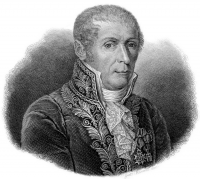










Alessandro Giuseppe Antonio Anastasio Volta was an Italian physicist known for the invention of the battery in the 1800s.
Early life and works
Volta was born in Como, a town in present-day northern Italy (near the Swiss border) on February 18, 1745. In 1794, Volta married an aristocratic lady also from Como, Teresa Peregrini, with whom he raised three sons: Giovanni, Flaminio and Zanino. His own father Filippo Volta was of noble lineage. His mother Donna Maddalena came from the family of the Inzaghis.In 1774, he became a professor of physics at the Royal School in Como. A year later, he improved and popularized the electrophorus, a device that produced static electricity. His promotion of it was so extensive that he is often credited with its invention, even though a machine operating on the same principle was described in 1762 by the Swedish experimenter Johan Wilcke.In 1777, he travelled through Switzerland. There he befriended H. B. de Saussure.
In the years between 1776–78, Volta studied the chemistry of gases. He researched and discovered methane after reading a paper by Benjamin Franklin of America on "flammable air". In November 1776, he found methane at Lake Maggiore,and by 1778 he managed to isolate methane.He devised experiments such as the ignition of methane by an electric spark in a closed vessel. Volta also studied what we now call electrical capacitance, developing separate means to study both electrical potential (V ) and charge (Q ), and discovering that for a given object, they are proportional. This may be called Volta's Law of capacitance, and it was for this work the unit of electrical potential has been named the volt.
In 1779 he became a professor of experimental physics at the University of Pavia, a chair that he occupied for almost 40 years.
First battery
In announcing his discovery of his voltaic pile, Volta paid tribute to the influences of William Nicholson, Tiberius Cavallo, and Abraham Bennet.
The battery made by Volta is credited as the first electrochemical cell. It consists of two electrodes: one made of zinc, the other of copper. The electrolyte is either sulfuric acid mixed with water or a form of saltwater brine. The electrolyte exists in the form 2H+ and SO42?. The zinc, which is higher than both copper and hydrogen in the electrochemical series, reacts with the negatively charged sulfate (SO42?). The positively charged hydrogen ions (protons) capture electrons from the copper, forming bubbles of hydrogen gas, H2. This makes the zinc rod the negative electrode and the copper rod the positive electrode.
Thus, there are two terminals, and an electric current will flow if they are connected. The chemical reactions in this voltaic cell are as follows:
zinc
Zn ? Zn2+ + 2e?
sulfuric acid
2H+ + 2e? ? H2
The copper does not react, but rather it functions as an electrode for the electric current.
However, this cell also has some disadvantages. It is unsafe to handle, since sulfuric acid, even if diluted, can be hazardous. Also, the power of the cell diminishes over time because the hydrogen gas is not released. Instead, it accumulates on the surface of the zinc electrode and forms a barrier between the metal and the electrolyte solution.
Last years and retirement
In honor of his work, Volta was made a count by Napoleon Bonaparte in 1810.His image was depicted on the Italian 10,000 lira note along with a sketch of his voltaic pile.
Volta retired in 1819 to his estate in Camnago, a frazione of Como, Italy, now named "Camnago Volta" in his honor. He died there on March 5, 1827.Volta's remains were buried in Camnago Volta.
Volta's legacy is celebrated by the Tempio Voltiano memorial located in the public gardens by the lake. There is also a museum which has been built in his honor, which exhibits some of the equipment that Volta used to conduct experiments. Nearby stands the Villa Olmo, which houses the Voltian Foundation, an organization promoting scientific activities. Volta carried out his experimental studies and produced his first inventions near Como.